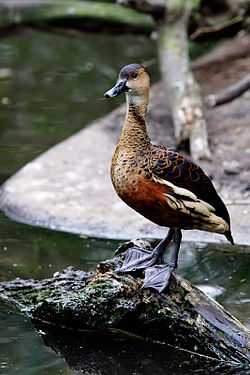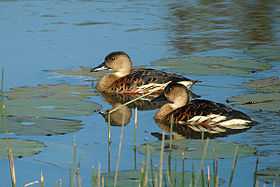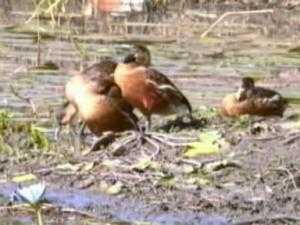Wandering whistling duck
| Wandering whistling duck | |
|---|---|
 | |
| Conservation status | |
| Scientific classification | |
| Kingdom: | Animalia |
| Phylum: | Chordata |
| Class: | Aves |
| Order: | Anseriformes |
| Family: | Anatidae |
| Subfamily: | Dendrocygninae |
| Genus: | Dendrocygna |
| Species: | D. arcuata |
| Binomial name | |
| Dendrocygna arcuata (Horsfield, 1824) | |
| Subspecies | |
| |
The wandering whistling duck (Dendrocygna arcuata) is a species of whistling duck. They inhabit tropical and subtropical Australia, the Philippines, Borneo, Indonesia, Papua New Guinea and the Pacific Islands.[2]
Taxonomy
There are three subspecies associated with this bird, D. a. arcuata (Indonesian wandering whistling duck), D. a. australis (Australian wandering whistling duck), and D. a. pygmaea (New Britain wandering whistling duck).
Description
Formerly named tree ducks, the wandering whistling duck has its new name because of their loud whistling calls and the whistling noise their wings make during flight. They have long necks and legs and look like a cross between a goose and a duck. They have a strong head and neck with a darker crown and hindneck. The breast contains black spotting and the feathers are mostly dark brown. They range in size from 54–60 cm in height and weigh on average 750 grams. They mainly feed on grasses, waterlillies, water plants and occasionally insects and aquatic vertebrae.
Habitat
The wandering whistling duck lives in deep lagoons, flooded grasslands or dams. They enjoy the water and rarely leave the shore. They can swim and dive with ease.
Breeding
Breeding occurs during the tropical wet season usually between December and May. During this time six to fifteen eggs are laid in a nest not far from water and usually in high grass or a sheltered area.



References
- ↑ BirdLife International (2012). "Dendrocygna arcuata". IUCN Red List of Threatened Species. Version 2013.2. International Union for Conservation of Nature. Retrieved 26 November 2013.
- ↑ Pizzey, Graham; Knight, Frank (1997). Field guide to the birds of Australia (3rd ed.). Angus & Robertson. p. 26. ISBN 0-207-19714-8.
